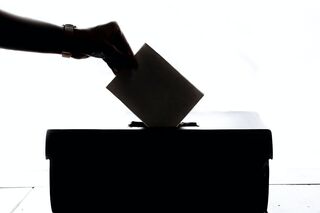Sexual Orientation
Can 3 Types of Voters From 2016 Shed Light on the 2020 Vote?
New research reveals how beliefs about sexual orientation predicted 2016 votes.
Posted September 27, 2020
As we move further into fall and closer to the 2020 U.S. election, you may be wondering whether anything learned from the 2016 election might inform us about voting behaviors expected in the 2020 election. While the two elections are significantly different, in that the 2016 election asked voters to choose between a man and a woman for the first time in U.S. history and the 2020 election is taking place amidst an unprecedented global pandemic that has seen more than 200,000 American lives lost, the two elections are still tied together closely in that one of the names on the ticket remains the same.

What then can we learn about elections in general and specifically elections involving Donald Trump? Are there certain beliefs about specific topics that can help us to better understand who might vote for whom? In a recent article published in the APA’s Psychology of Sexual Orientation and Gender Diversity, researchers asked whether a person’s beliefs about sexual orientation were associated with how they voted in the 2016 U.S. Presidential Election. Given that LGBTQ civil liberties have remained a topic of debate during Donald Trump’s first term, it seems plausible that the results of such a study may shed some light on how voters will approach their choice between Joe Biden and Donald Trump in November 2020.
But what is meant by “beliefs about sexual orientation”? The authors articulate that, contrary to attitudes, which involve an evaluative judgment, beliefs can be either positive or negative and relate more to the questions of existence and categorization, or understandings of how we make sense of our world and specific categories within that world. More specifically, the researchers investigated ‘lay beliefs’ about sexual orientation, or the ways in which average individuals come to think and understand the notion of sexual orientation and its causes.
Using the Sexual Orientation Beliefs Scale, researchers examined the extent to which individuals believe that people are born with their sexual orientation (naturalness), that someone can have only one sexual orientation (discreteness), that individuals who share a sexual orientation share many other things in common as well (homogeneity), and that knowing someone’s sexual orientation is an important means of understanding that person (informativeness).
Participants, 286 young adults between the ages of 18-25 with the intention of voting in the 2016 election, completed a survey before, during, and after the election that assessed a variety of topics, including their stress and emotions, as well as their beliefs about sexual orientation, the number of LGBTQ friends they had, and their levels ambivalent sexism. By assessing participants’ beliefs about sexual orientation, the researchers were able to identify three main belief profiles.
The first profile was referred to as ‘multidimensional essentialism,’ in which participants had moderate-to-high scores on all four categories of the sexual orientation belief scale (e.g., naturalness, discreteness, homogeneity, and informativeness). The second group was referred to as high DHI, identifying this group as having the highest scores on the discreteness, homogeneity, and informativeness scales. The third and final group was referred to as ‘naturalness-only’ and were unique in that while they had similarly high scores on naturalness beliefs about sexual orientation, the remainder of their scores on the other three categories were lower than those of the participants in the other two groups.
After identifying the three groups based on shared belief profiles, researchers examined what predicted being in each group and how the groups differed in terms of their voting intentions in the 2016 election. Notably, belief in sexual orientation being ‘innate’ or inborn (i.e., the ‘born this way’ belief), was relatively stable across the four groups and did not usefully distinguish participants from each other in any meaningful way. Thus, believing that sexual orientation is innate had no bearing on whether someone had LGB friends or who they voted for in the U.S. election. This is an important contribution to the literature, as the ‘born this way’ argument was previously used as a means of changing attitudes and reducing prejudice, but has more recently faced critique. The authors suggest that while this belief may now be much more widespread, the increase in this belief alone has not resulted in the eradication of prejudice directed at sexual minorities.

Individuals who had the highest scores on discreteness, homogeneity, and informativeness (the high DHI group) were the most likely to be Republicans and to report voting for Donald Trump (47.7%) in 2016, a significant increase over the other two groups, with 10.1% in the multidimensional essentialism group voting for Trump and only 1.6% of those in the naturalness-only group reporting an intention to vote for Trump. The key distinguishing factors between the high-DHI and multidimensional essentialism group were their scores on discreteness and homogeneity. Those who reported believing that sexual orientation categories do not overlap or that you cannot have more than one sexual orientation and who also reported believing that, for example, lesbian women are very similar to one another, were the most likely to indicate an intention to vote for Donald Trump. Beliefs about the informativeness of sexual orientation did not differ significantly between the two groups.
While the authors are careful to note that they are not opposed to ‘born-this-way’ beliefs about sexual orientation, they interpret their findings as evidence that those interested in reducing prejudice against sexual minorities may be well served to broaden their approach and to incorporate means of increasing understandings of sexual orientation that emphasize the fluidity of sexual identity and the commonalities that link individuals across sexual orientation categories. Indeed, with the growing divisions between Republicans and Democrats, Liberals and Conservatives, and generally any seemingly opposed groups within our society, emphasizing common ground might be a wise approach on any topic.
References
Grzanka, P. R., Zeiders, K. H., Spengler, E. S., Hoyt, L. T., & Toomey, R. B. (2020). Do beliefs about sexual orientation predict voting behavior? Results from the 2016 U.S. presidential election. Psychology of Sexual Orientation and Gender Diversity, 7(3), 241–252. https://doi.org/10.1037/sgd0000434


